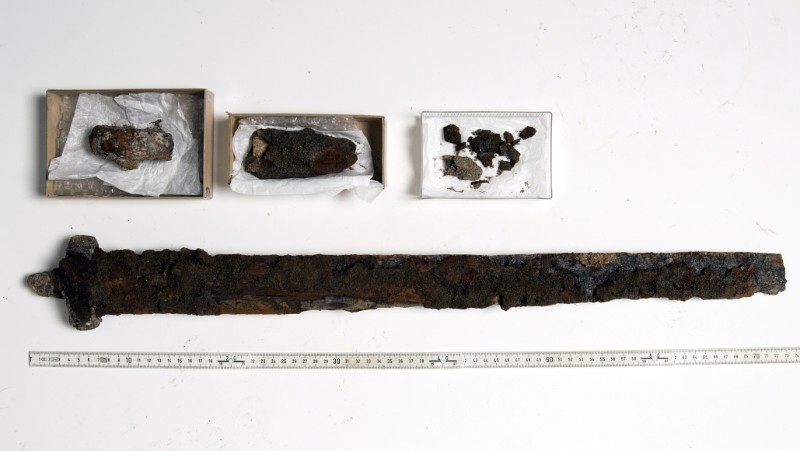Construction workers building residential homes in the village of Melhus, central Norway, have unearthed an unusually well-preserved Viking sword, possibly from a grave site. The developer alerted archaeologists from the Museum of Natural History and Archaeology, a department of the Norwegian University of Science and Technology in Trondheim, just south of Melhus. They confirmed that the piece is indeed a Viking weapon, a Type H sword, according to Jan Petersen’s classification system, which dates it to between 800 and 950 A.D. A small companion piece, probably a knife blade, was found buried with it.

Despite its corroded appearance and missing parts, the sword retains organic elements, pieces of wood and leather that researchers believe are the remains of the hilt and scabbard respectively. It was discovered embedded in clay covered by five feet of topsoil, which is why those delicate organic materials were preserved for over a thousand years even as the area was cultivated and built over.
Archaeologists have excavated the find site before but never found anything. The area was reputed to have several Viking burials, but they were razed for construction during the late 19th century. This find is the sole indication that there might be still be human and material remains from the Viking era on the spot.
Construction has been suspended for now and the Trondheim team has asked for permission to excavate the site as quickly as possible.
The village of Melhus has a strong connection to 10th century Viking history. An infamous murder recounted in The Saga of King Olaf Tryggvason took place in a farm in Melhus, that of Haakon Sigurdsson, aka Jarl Haakon, aka Earl Haakon, who ruled Norway for 20 years (975-995). Officially he held the country as a vassal of Danish King Harald Bluetooth, but in practice he had full autonomy.
Haakon and Bluetooth would quarrel, however, over religious matters. Haakon worshipped the old Norse gods, so he didn’t respond well when Bluetooth forcibly baptised him and tried to pack his return ship to Norway with Christian missionaries. Haakon dumped the priests before his departure, then switched allegiance to Bluetooth’s enemy Holy Roman Emperor Otto II. He held his own on the battlefield and successfully fended off Danish raids on Norway, including one by the fearsome Jomsvikings.
The constant wars began to chip away at Haakon’s popularity, as did his habit of taking the daughters of noblemen for his concubines then sending them home despoiled when he tired of them after a week. When Olaf Tryggvason, son of a Norwegian kinglet and direct descendant of the first king of Norway, got wind of Haakon’s political troubles, he sailed to Norway to win himself a kingdom.
Meanwhile, a rebellion against Haakon’s rule drove the Earl into hiding. He and his slave Kark hid in a cave one night, then the next night dug a hole under a pigsty in a farm in Melhus and hid in there. Olaf and his soldiers unwittingly caught up with him. Olaf even gave a rousing “bring me his head” speech right outside the sty before moving on.
Then Olaf held a House Thing (trusting), or council out in the yard, and stood upon a great stone which lay beside the swine-stye, and made a speech to the people, in which he promised to enrich the man with rewards and honours who should kill the earl. This speech was heard by the earl and the thrall Kark. They had a light in their room.
“Why art thou so pale,” says the earl, “and now again black as earth? Thou hast not the intention to betray me?”
“By no means,” replies Kark.
“We were born on the same night,” says the earl, “and the time will be short between our deaths.”
King Olaf went away in the evening. When night came the earl kept himself awake but Kark slept, and was disturbed in his sleep. The earl woke him, and asked him “what he was dreaming of?”
He answered, “I was at Hlader and Olaf Trygvason was laying a gold ring about my neck.”
The earl says, “It will be a red ring Olaf will lay about thy neck if he catches thee. Take care of that! From me thou shalt enjoy all that is good, therefore betray me not.”
They then kept themselves awake both; the one, as it were, watching upon the other. But towards day the earl suddenly
dropped asleep; but his sleep was so unquiet that he drew his heels under him, and raised his neck, as if going to rise, and screamed dreadfully high. On this Kark, dreadfully alarmed, drew a large knife out of his belt, stuck it in the earl’s throat, and cut it across, and killed Earl Hakon. Then Kark cut off the earl’s head, and ran away. Late in the day he came to Hlader, where he delivered the earl’s head to King Olaf, and told all these circumstances of his own and Earl Hakon’s doings. Olaf had him taken out and beheaded.
Olaf Tryggvason ruled for just 5 years, but he cast a long shadow. He forcibly converted Norway to Christianity, giving people the choice of converting to Christianity or suffering torture and execution.